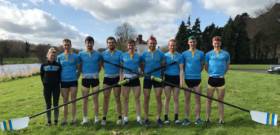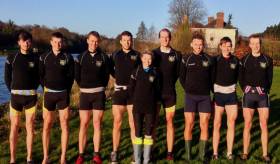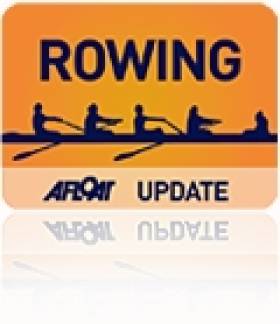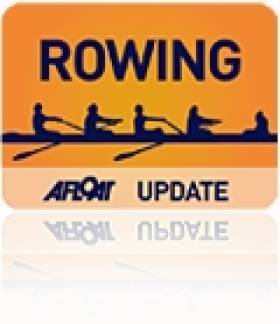Displaying items by tag: Corcoran Cup
UCD take Gannon Cup after Tough Battle
#Rowing: UCD won the Gannon Cup for senior men and Trinity the Corcoran Cup for senior women at the Colours Races in Dublin today.
Trinity lead early in the Gannon, but once the crews came through Grattan Bridge, UCD pushed into the lead. The lead stood at one length through the next four bridges, but Trinity whittled it to two-thirds from there, making for a good finish. UCD held on to win.
Trinity were outstanding winners of the Corcoran Cup. They carved out a big lead early on and went on to win easily.
UCD’s novice women also built on a good start to win the Sally Moorhead trophy, while Trinity won the men’s novice race and took the Dan Quinn Shield.
Colours Races 2019, Dublin
Gannon Cup (Senior Men): UCD (Rob Brown, Jack Stacey, Andrew Goff, Shane O’Connell, Thomas Earley, Andrew Kelly, Cameron Murphy, David O’Malley; cox: Orlagh Reid) bt Trinity 2/3 l
Corcoran Cup (Senior Women): Trinity (Anna Mangan, Ellen Clohessy, Ruthie McHugh, Jane Hogg, Aoife Corcoran, Erika Deasy, Miriam Kelly, Aoife McGranaghan; cox: Clare White) bt UCD easily
Dan Quinn Shield (Novice Men): Trinity bt UCD 3l
Sally Moorhead Trophy (Novice Women): UCD bt Trinity 3l.
Trinity Draw on Fitness to win Gannon Cup
#Rowing; Trinity won the Gannon Cup with a fine performance today. The Colours races were run on a reverse of the Trinity Regatta course above the weir for safety reasons. There was a strong east wind and a powerful flow.
UCD took a one-length lead in the Gannon Cup at the first bend, but Trinity came back to lead and held on. Trinity’s senior women won the Corcoran Cup with a commading performance.
The novice women’s title (the Sally Moorhead Trophy) was won easily by UCD. The closest race of the day was the novice men’s race, which was a thrilling contest. Trinity led past the boat clubs, but UCD overtook them and led by a length. Trinity came back to retake the lead … only for UCD to overhaul them right at the finish line.
Colours Races 2018, Islandbridge (raced above the weir because of bad weather)
Senior Men (Gannon Cup): Trinity (B Cronin, D Butler, W Doyle, G Moore, A Liadov, D Pierse, T Hughes, M Quigley; cox: R Hamilton) bt UCD, ¾ l.
Novice Men (Dan Quinn Shield): UCD bt Trinity 2ft.
Senior Women (Corcoran Cup): Trinity (D Maguire, S Kelly, A Byrne, J Hogg, A Corcoran, C Dempsey, L McHugh, S Higgins; cox: M Jungmann) bt UCD easily.
Novice Women (Sally Moorhead Cup): UCD bt Trinity easily
UCD in Command in Gannon Cup
#Rowing: UCD came out on top in the Gannon Cup for senior men and the Corcoran Cup for senior women on the Liffey today – but in very different races.
Trinity led for most of the Corcoran Cup race, holding off strong UCD pushes. It looked set up for an excellent finish – but then Trinity’s rudder fell off. They had terrible steering difficulties, and UCD powered through to win well.
UCD’s senior men were in command from early on. They made light of their weight disadvantage into the strong, gusting, wind to build a good lead, despite rowing on the South Station, which is less favoured in the early stages.
Trinity won the novice men’s race and UCD the novice women’s.
Colours Races 2017
Men, Senior (Gannon Cup):
UCD (S Bolger, S O’Connell, T Doherty, M Murphy, S Mulvaney, A Griffin, E Gleeson, D O’Malley; cox: O Reid) bt Trinity 3l.
Novice (Dan Quinn Shield): Trinity bt UCD 2l
Women, Senior (Corcoran Cup)
UCD (S Matthews, V Connolly, R Ryan, G Youl, D Callanan, J Coleman, R Gilligan, E Lambe; cox: S Ní Fhinn) bt Trinity easily.
Novice (Sally Moorhead Trophy); UCD bt Trinity easily.
UCD Take Gannon and Corcoran Cups
#Rowing: UCD carried off the Gannon and Corcoran Cups for senior men and women in the Colours races on the Liffey today. In both races, strong starts in the difficult conditions were the key. In the Corcoran Cup, the bigger and more powerful UCD women’s crew had one quarter length by the Ha’penny Bridge, and coming through Capel Street Bridge they extended it to over a length. They went on to win comfortably. The UCD men’s crew also got off the start much more smoothly than Trinity. Trinity mounted a number of attacks down the course, but UCD held them off and won by over a length.
The novice men’s race for the Dan Quinn Shield provided Trinity with a chance to impress, with the crew in white taking command early and having the race won by the Four Courts. The novice women’s race was similarly one-sided, with UCD having only to paddle home after Trinity’s stroke woman caught a crab after only a few seconds of the race.
Colours Races 2016, O’Connell Bridge to St James’s Gate, Saturday:
Men – Senior (Gannon Cup): UCD (E Gleeson, D Somers, T Hughes, A Griffin, E O’Connor, M Murphy, S Mulvaney, D O’Malley; cox: O Reid) bt Trinity 1 1/3 l . Novice (Dan Quinn Shield): Trinity bt UCD, easily.
Women – Senior (Corcoran Cup): UCD (D Callanan, J Coleman, A O’Riordan, E Lambe, O Finnegan, R Gilligan, S Bennett, K O’Connor; cox: J Gilligan) bt Trinity a distance. Novice (Sally Moorhead Trophy): UCD bt Trinity easily.
Clean Sweep for Trinity over UCD on Liffey
#ROWING: Trinity won all four Colours races on the Liffey today. In the Gannon Cup for senior men, the men in black and white hoops took a small early advantage, stretched it to three-quarters of a length by Capel Street Bridge and won by one-and-a-half lengths. The two novice races were surprisingly one-sided for the Dublin University crews. The best race of the day was the women’s senior contest, for the Corcoran Cup. UCD took an early advantage and led for most of the race. But Trinity were impressively controlled in their rowing and took the lead through the last two bridges. They stretched their advantage to half a length at the finish.
Colours Races 2015, Liffey, Dublin, Saturday, March 14th.
Senior Men (Gannon Cup): Trinity (A Browne, W Doyle, J Magan, M Corcoran, P Moreau, M Kelly, L Hawkes, D Butler; cox: C Flynn) bt UCD 1½ l
Novice (Dan Quinn Shield): Trinity bt UCD, easily
Senior Women (Corcoran Cup): Trinity (G Crowe, H O’Neill, H McCarthy, S Healy, S O’Brien, A Leahy, L McHugh, R Morris; cox: N Williams) bt UCD ½ l
Novice (Sally Moorhead trophy): Trinity bt UCD easily
UCD Rowers Win Terrific Gannon Cup Race
#ROWING: UCD won the Gannon Cup for senior men after a terrific struggle, while Trinity senior women took the Corcoran Cup in facile fashion at the Colours Rowing Races on the Liffey today.
Trinity’s crew led the Gannon Cup race from just after the start, but could not gain a clearwater lead. UCD’s pushes were relentless, and though they were still behind coming through the final bridge, Watling Street, they then powered through and had command of the race when Trinity’s number four man and captain, Luke Acheson, collapsed. The race was not rowed out. It took a long time – too long - to get Acheson into an ambulance, as he had to be brought up the river all the way to City Quay before being lifted up the steps. He was being treated in St James’s Hospital this afternoon.
Trinity’s Corcoran Cup crew demonstrated that size is not everything in rowing. They were outsiders, but simply rowed better than UCD. They eked out an early lead and built it steadily into an unassailable margin by the end.
UCD’s annexation of the Sally Moorhead Trophy for novice women was also one-sided, but Trinity took the novice men’s title after UCD suffered a boat-stopping crab right in front of the Four Courts. UCD came back to lead briefly, but Trinity took control again before the finish.
Colours Rowing Races, O’Connell Bridge to St James’s Gate
Men – Senior (Gannon Cup): UCD (M Bailey, W Yeomans, C O’Riada, B Crosse, D O’Neill, A Griffin, P Moore, N Kenny (stroke); cox: L Mulvihill) bt Trinity not rowed out. Novice (Dan Quinn Shield): Trinity bt UCD 1 ½ l.
Women – Senior (Corcoran Cup): Trinity (G Crowe, H O’Neill, H McCarthy, R Deasy, S O’Brien, A Leahy, S Cass, R Morris (stroke); cox: N Williams) bt UCD easily.
Novice (Sally Moorhead Trophy): UCD bt Trinity easily.


































































